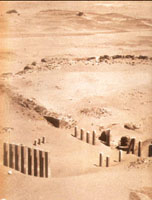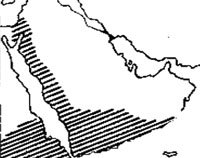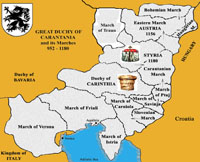
The link between the ancient Yemeni kingdom and the ancient Slovenian State of Carantania uncovered:From Marib to Carantania [Archives:2004/765/Culture]
August 19 2004
 |
 |
 |
Yemen Times Staff
[email protected]
The oldest history of Yemen is connected with the city of Marib and its dam. Ancient Marib was the largest of the incense cities, it held a commanding position for the transportation of frankincense on the important caravan route that ran from the areas on the Indian Ocean to the shores of the Mediterranean. It was not until Adeeb Mahfood from Jamaica, and his cousin Hashem Hashem from Canada, in searching for their own original family in Yemen, uncovered the long suspected link between the ancient Yemeni kingdom and ancient Carantania. They provided history of the Gebara family and other Arab linages a result of their seven year long research. What follows here is perhaps a personal journey, and search for a lost identity and history.
Chronology of the Area of Marib in Yemen
1700 B.C. Legendary date for the building of the dam at Marib.
1000 B.C. Sabeans settle in the Marib area
950 B.C. Traditional day for Bilquis, Queen of Sheba (Saba), 925 B.C. Death of King Solomon.
800-700 B.C. Name of the traditional rules of Saba are known from about this time. They were called “mukarrib”, the term probably meant “priest-king”.
800 B.C. Traditional date for the “building of the dam at Marib”. The reference here probably means the rebuilding of the dam, and possibly the building of the great sluices.
715 B.C. the successive Assyrian Kings receive tributes of gold, precious stones, spices, horses and camels from the Sabeans.
600-500 B.C. Sabeans send trading colonists to India.
587 B.C. Defeat of Jerusalesm by Nebuchadnezzar, King of Babylon. Prophet Ezekiel writes about trade with the Sabeans at this time.
410 B.C. Karib il Watear listed as the first “king” of Saba. Change here is from “mukarrib” to “king”.
100 A.D. Alhan Nahfan Hamadanid, King of Saba forms alliances with Hadramaut and Ethiopia.
200 A.D. and after Saba under the hegemony of Himyar. Himyar, kings calling themselves kings of Saba and Dhu Raydan.
Following two centuries is one of conflict with Ethiopia and Persia, siding first with one then another South Arabian fraction. This time is also one of ferment in religion with both Judaism and Christianity prominent at various periods.
Due to heavy rains and floods, the great dam at Marib was already destroyed. Proverb “scattered like the people of Saba” refers to that exodus in history.
622 A.D. Hijra, Mohammads flight from Mecca to Medina and beginning of the Islamic era.
Rome was known as the furthermost and northernmost capital that the ancient Yemeni diplomats were appointed to. Sabeans also sent a diplomatic mission to meet Emperor Octavianus Augustus at the Greek island of Samos. Through archeological evidence there is proof of Sabean presence throughout the East Africa from Egypt to Tanzania, and coast of India and Indochina
Tha Banu Ghassan
The political dynamics of Pre-islamic Arabia can be summarized by the interaction of three major forces: the Gassanids, the Lakhimids, and the Kindah or Kinda. The Ghassanids were a south Arabian Yemeni tribe. Banu Ghassan, migrated north (of Marib) during the third and fourth centuries, but mostly after the break up of the great Marib dam and settled in the region of Damascus. Christian by religion, they allied themselves with Byzantium. They also agreed to protect the southern flank of the Byzantine Empire against the intrusion of other Arab tribes. This alliance held well throughout the wars between the Byzantines and the Persian Empires. Another group emigrated and settled in Hira, where they established the kingdom of Lakham. During 6th Century, after the departure of the two major empires of the time, the Byzantine and the Persian, many Ghassanids allied themselves with the increasingly dominating Arab tribes from the heartland of Arabia. This political dynamic is important, because it is out of the interaction of the Arab tribes and the leaders of these kingdoms that the early Islamic community, and later the Islamic Empire, emerge.
Their country was the caravan, their life the most unexpected of voyages. As any journey, theirs would be ruled by the twin houses of mystery and discovery. Their wrists experienced in turn the caresses of silk, the abuses of wool, the gold of princes and chains of slaves. Their eyes saw cities die and empires perish. And their camels moved forward in time with the rise and fall of its rhythm.
Once crowded incense road ran some 2,400 miles through Arabia, from southern Oman, through high Yemeni mountains, across the dunes and black volcanic deserts of Saudi Arabia to Petra. In Roman times, a rugged journey of some 80 marches, offered challenges. To them frankincense symbolized divinity, an offering on a par with gold and myrrh, another Arabian incense also prized for medicine. Thousand of years earlier Egyptians were using the “perfume of the gods” for temple rites. The road to the Yemeni Arab sea coast is covered with frankincense groves. Only here do trees find conditions ideal. It is here that the Arabian dessert makes a quick change. A roof of monsoon clouds suddenly quenches the blinding sun. The air chills as the road climbs gently. The caravans left behind the granite hills that soon floated like dark, low clouds on a shimmering mirage. Camels with their soft padded feet moved easier on that soft sand that skirts the southwest sand of the Empty Quarter, a great blank on Arabians maps. Small clay figures found in Yemen and dating from 1000 B.C are among the earliest depictions of the camel. Thriving on harsh vegetation that would starve other beasts, the camel provides milk, wool, meat and leather. As the Holy Kuran notes “only on them, as well as on ships, ye ride” Ancient ghost town Haribart, AlJubah, AlMasajid marked the way.
The glory of Sheba or Saba seems to linger in the ancient capital of Mareb, where the fabled Queen who brought to King Sulaiman “such an abundance of spices” may once have ruled. There is also an oval shaped temple of the shape of the moon. Past Najran some 60 miles to the north at Bir Hima, ancient caravans left thousand of inscriptions on the sandstone. Most the simple grafitti of rustics, some are illustrated with scenes of camel herds, a date harvest, ibex, hunters wielding spear. From Petra the incense traveled on to Gaza, across the Sinai to major processing plants in Alexandria, north to Palmyra and Damascus, east to Euphrates. Markings similar to those at Marib, perhaps a merchant monograph, were found on vessels at the other end of the incense route – at Gaza on the Mediterranean.
Amre, son of Amre from Saba emigrated with his family and many of his followers north (of Marib). They settled in Houran. After their departure from Yemen, Houran became their first home. The land of Houran lies about twenty miles to the south of Damascus. It is a vast region with mountains, valleys and plains. The climate is mild and its soil fertile. The Ghassanids were named after the well where they first settled upon their arrival from Yemen. Amer El-Ghatreef, known also as “maussma”, meaning the “Water of Heaven” for his generosity, became the first Ghassanid King. He lived about the beginning of the third century AD. The Ghassanids would soon became the leaders of all Arab tribes in Syria. Even the city of Damascus was under their rule. Also the country known today as Jordan used to be under their control.
*The Ghassanids – poets, men of literature and arts
The Ghassanids Kingdom extended as far as the Red Sea to the South and the Euphrates to the north, the Jordan and Yarmuk valleys were included in their realms, the city of Joulan, known today as Balkaa was their capital. The ruins of palaces, churches, castles, public baths, and aqueducts in Houran are evidence of the sophistication of their culture and civilization. The Banu Ghassan lived in a palace in the middle of the town and administered their vast realms. They traded extensively. The Greeks gave the Ghassanids kings the title “Elharith” and the kings of Hira the title of “El-Munzer”. These two titles were equivalent to title of Pharaon of Egypt, Negus in Abyssinia and Caesar in Rome. The Emperors of Constantinople gave them the tile of “Patrik” meaning the father.
The Ghassanid kings became known for their generosity. The last to succeed the throne was Jeblet son of El-Ayham who built the town of Jeblet that lies between Latakieh and Tripoli. He was such a good and strong king that for decades after his death his name was a symbol of strength and glory. With his death and the coming of the Islam, the Ghassanids again were scattered far and wide.
The Gebaras, Gbara, Jebera, Jebara, Sceberras
Historical evidence shows that some Christian families in Syria and Lebanon and especially the Gebaras, were direct descendants of the noble Ghassanids. They originated from the city of Azra in the land of Houran. In the past the town of Azra used to be known also as Azrai, meaning the fortress. It lies about 75 five miles away from Bosra Eskj Sham, about 612 km above sea level. Azra is an old town known for its ancient Greek and Roman connections. Many of the battles between the Crusaders and the Moslems were fought on its grounds and streets.
As the Banu Ghassan, the Gebaras were interested in art, literature and especially poetry.
The story of the Gebara ancestry has been passed down through the ages from father to son, confirms:
That they were of the Ghassanid origin and then came to Lebanon after the Moslem conquest from Houran and prior that from Yemen and were of Greek Ortodox faith. Some of them still live in Azra, but the majority went to Damascus and Acre, some came to Arjeyoun and Kornet Shahwan.
Their features were confirmed as follows: high temple, big noses, prominent foreheads, fuzzy hair, small jaws, thin lips, beautifully straight teeth, well proportioned features, dark complexions, black eyes and beautiful figures. Further generosity, contentment, fondness of country life, bravery, distinguished looks and benevolence. In all ages and epochs the Gebaras -Jebaras -Jeberas – Sceberras went through, there were among them men and women who are outstanding in bravery, administrative work, learning, religion, and writings. Among them are generals, administrators, bishops, priests, monks, physicians, pharmacists, scientists, lawyers, merchants, and benefactors.
The Gebara family includes both Christians and Moslems. The Moslem Gebaras adopted Islam during the time of Arab conquest, and migrated with the respective Moslem community. The Moslem Gebaras went to El-Median, Yunbu, Asffan, Alexandira, Beer Sheba, Jub Jennine, Majdal Balhiss, El-Kerou, and Tripoli.
The places where the Christian Gebaras went are Damascus, Marjeyoun, Kornet Shahwan, Jebbata el-Zeit, Ammatour, Zahleh, Jell elDeeb, Ain Aiir, Aleppo, Alexandria, Austria/Slovenia – then named Carantania, which was probably known to them from their extensive trading contacts.
Was ancient Carantania their timber supplier? Slovenian scholar Dr. Jozko Savli says it probably goes back to a very old link that goes all the way to Yemen and to the ancient Sabean kingdom.
Others proceeded to Greece, Turkey, the rest remained in Azra – A group of Gebaras who went to Alexandria (Egypt) proceeded to Malta and gave rise to one of the finest aristocratic Maltese families. Names of the families who settled in Merjyoum (present day Lebanon):
The Jebara, the Gholmia, the Bayouth, the Razook, the Andeel, the Rashid, the Naifeh, the Barakat, the Farha, the Hamara, the Farhood, the Rahal, the Theeba, the Mady.
On this autumn day, the yellowing leaves in Azra were more securely attached to the trees, their city was divided. Orchards have been laid to waste, the peasants would complain. And the night hid his face. How many great kings, or inspired poets, or intrepid travelers have never been able to attain the destiny which seemed promised to them? On each new shore, they attached the name of the homeland they had left behind. The Slovenian Julian Alps were the first mountain barrier separating the Mediterranean from Continental Central Europe. A largely mountainous region, almost half of it covered with forests, pastures, fields, vineyards and orchards. The snow fell continuously, covering the land with a veil of peace and serenity which nothing seemed able to destroy. They no longer saw land, nor sea, nor sun, nor the end of their journey, or weather they would encounter death or glory. Wherever you will go, some will want to ask questions about your skin or your prayers. Muslim, Jew or Christian, beware of bending before the multitude. When mans mind seems narrow to you, tell yourself that the land of God is broad, broad are His hands and broad is His heart. Never hesitate to go far away beyond all seas, all frontiers, and all beliefs. I for my part – so it seems – have reached the end of my wanderings.
The white community in Europe too is composed of three main cultures, western, eastern and southern. The “southern culture” in Europe is at least known and acknowledged. One thing is certain: half buried along the frankincense trail from the sacred groves of Yemen, to the fragrant alters of Rome, to the rose gardens of Damascus and the deep forests of ancient Carantania, waiting to be read, lies a compelling chapter in the history of man.
Apologia
I am much indebted to Adeeb Mahfood in Jamaica and Hashem Hashem in Canada whose mother was a real Gebara, for providing the lead, their family references and history. My profound thanks to Slovenian scholar Dr. Jozko Savli, and author of the book “The Slovenian State of Karantania”.
References and further reading:
Chronology for the area of Marib, The American Institute for Yemeni Studies, Sanaa, Yemen – Prof. Dr. Muhammad Shamsaddin Megalommatis, The Diachronic Supremacy of Yemen, in Yemen Times, issue 756, 19th July 2004, Sanaa, Yemen – Irfan Shahid, Byzantium and the Arabs in the Sixth Century, ISBN: 0-88402-284-6, The Gebara family site http://gebara.marjeyoun.net – Raymond Faris Gebara, The rise of the Ghassanids in Gebara family site.
For Marib, the Sabean Capital to Carantania will be published in full on Gebara family site and on Carantania web site of Slovene history: www.niagara.com/~jezovnik
——
[archive-e:765-v:13-y:2004-d:2004-08-19-p:culture]


